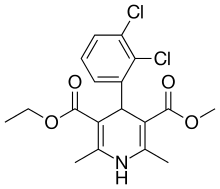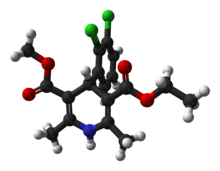Felodipine
Felodipine is a medication of the calcium channel blocker type which is used to treat high blood pressure.
 | |
 | |
| Clinical data | |
|---|---|
| Trade names | Plendil |
| AHFS/Drugs.com | Monograph |
| MedlinePlus | a692016 |
| Pregnancy category |
|
| Routes of administration | Oral |
| ATC code | |
| Legal status | |
| Legal status |
|
| Pharmacokinetic data | |
| Bioavailability | 15% |
| Metabolism | Hepatic |
| Onset of action | 2.5–5 hours |
| Elimination half-life | 25 hours[1] |
| Excretion | Renal |
| Identifiers | |
IUPAC name
| |
| CAS Number | |
| PubChem CID | |
| IUPHAR/BPS | |
| DrugBank | |
| ChemSpider | |
| UNII | |
| KEGG | |
| ChEBI | |
| ChEMBL | |
| CompTox Dashboard (EPA) | |
| ECHA InfoCard | 100.149.305 |
| Chemical and physical data | |
| Formula | C18H19Cl2NO4 |
| Molar mass | 384.259 g/mol g·mol−1 |
| 3D model (JSmol) | |
SMILES
| |
InChI
| |
| (verify) | |
It was patented in 1978 and approved for medical use in 1988.[2]
Medical uses
Felodipine is used to treat high blood pressure and stable angina.[1][3]
It should not be used for people who are pregnant, have acute heart failure, are having a heart attack, have an obstructed heart valve, or have obstructions that block bloodflow out of the heart.[1]
For people with liver failure the dose needs to be lowered, because felodipine is cleared by the liver.[1]
Adverse effects
The only very common side effect, occurring in more than 1/10 people, is pain and swelling in the arms and legs.[1]
Common side effects, occurring in between 1% and 10% of people, include flushing, headache, heart palpitations, dizziness and fatigue.[1]
Felodipine can exacerbate gingivitis.[1]
Interactions
Felodipine is metabolized by cytochrome P450 3A4, so substances that inhibit or activate CYP3A4 can strongly effect how much felodipine is present.[1]
CYP3A4 inhibitors, which increase the amount of felodipine available per dose, include cimetidine, erythromycin, itraconazole, ketoconazole, HIV protease inhibitors, and grapefruit juice.[1][4]
CYP3A4 activators, which decrease the amount of felodipine available per dose, include phenytoin, carbamazepine, rifampicin, barbiturates, efavirenz, nevirapine, and Saint John's wort.[1]
Mechanism of action
Felodipine is a calcium channel blocker.[1] Felodipine has additionally been found to act as an antagonist of the mineralocorticoid receptor, or as an antimineralocorticoid.[5]
Different calcium channels are present in vascular tissue and cardiac tissue; an in vitro study on human vascular and cardiac tissues comparing how selective various calcium channel blockers are for vascular compared to cardiac tissue found the following vascular/cardiac tissue ratios: mibefradil 41, felodipine 12; nifedipine 7, amlodipine 5, and verapamil 0.2.[6]:172
Chemistry
Felodipine is a member of the 1,4-dihydropyridine class of calcium channel blockers.[6]:20–21 It is a racemic mixture, and is insoluble in water but is soluble in dichloromethane and ethanol.[6]:25
History
The Swedish company Hässle, a division of Astra AB, discovered felodipine;[7] it filed a patent application in 1979 claiming felodipine as an antihypertensive drug.[8][9] Astra partnered this drug and others with Merck & Co. in the US under a 1982 agreement between the companies.[7] The drug was approved by the FDA in 1991 after a three and a half year review; the drug entered a very crowded market the included the other calcium channel blockers nifedipine, verapamil, nicardipine, and isradipine.[7] The FDA gave the drug a 1C rating, meaning that it found little difference between felodipine and the drugs already approved for the same use.[7]
In 1994 Astra AB and Merck changed their partnership to a joint venture called Astra Merck,[10] and in 1998 Astra (by that time, AstraZeneca) bought out Merck's rights in the joint venture.[11]
The first generics became available in Sweden in 2003[12] and in the US in 2004.[13]:155
In April 2016, AstraZeneca announced that they were selling the right to market felodipine in China to China Medical System Holdings for $310 million; AZ would continue to manufacture the drug.[14]
Society and culture
As of 2016, felodipine was marketed under many brand names worldwide: Auronal, Cardioplen, Catrazil, Dewei, Dilahex, Enfelo, Erding, Fedil, Fedisyn, Feldil, Felicipin, Felo, Felocard, Felocor, Feloday, Felodil, Felodin, Felodip, Felodipin, Felodipina, Felodipine, Felodipino, Felodistad, Felogard, Felohexal, Felop, Felopine, Felostad, Feloten, Felotens, Felpin, Flodicar, Flodil, Keliping, Keydipin, Lodistad, Modip, Munobal, Nirmadil, Parmid, Penedil, Perfudal, Phelop, Phenodical, Plendil, Plentopine, Polo, Presid, Preslow, Prevex, Renedil, Sistar, Splendil, Stapin, Topidil, Vascalpha, Versant, and XiaoDing.[15]
The combination of felodipine and candesartan was marketed as Atacand.[15]
The combination of felodipine and ramipril was marketed as Delmuno, Tazko, Triacor, Triapin, Triasyn, Tri-Plen, Unimax, and Unitens.[15]
The combination of felodipine and enalapril was marketed as Lexxel.[15]
The combination of felodipine and metoprolol was marketed as Logimat, Logimax, and Mobloc.[15]
References
- "Felopidine UK label". UK Electronic Medicines Compendium. 15 September 2015.
- Fischer, Jnos; Ganellin, C. Robin (2006). Analogue-based Drug Discovery. John Wiley & Sons. p. 465. ISBN 9783527607495.
- "Felodipine US label" (PDF). FDA. October 2012.
- Jawad Kiani, Sardar Z Imam (30 October 2007). "Medicinal importance of grapefruit juice and its interaction with various drugs". Nutr J. 6 (33): 33. doi:10.1186/1475-2891-6-33. PMC 2147024. PMID 17971226..
- Luther, James M. (2014). "Is there a new dawn for selective mineralocorticoid receptor antagonism?". Current Opinion in Nephrology and Hypertension. 23 (5): 456–461. doi:10.1097/MNH.0000000000000051. ISSN 1062-4821. PMC 4248353.
- Joshi, Gajanan S.; Burnett, James C.; Abraham, Donald J. (2003). "Cardiac Drugs: Antianginal, Vasodilators, Antiarrhythmic". In Abraham, Donald J. (ed.). Burger's medicinal chemistry and drug discovery. Volume 3: Cardiovascular Agents and Endocrines (6th ed.). Hoboken, N.J.: Wiley. ISBN 9780471270904.
- "Merck's Plendil (Felodipine) Approved with "1C" Rating". Pink Sheet. 5 August 1991.
- Astrazeneca AB v. Mutual Pharmaceutical Co. (United States Court of Appeals for the Federal Circuit 2004). Text
- US patent 4,264,611, Berntsson, Peder; Carlsson, Stig & Gaarder, Jan et al., "2,6-Dimethyl-4-2,3-Disubstituted Phenyl-1,4-Dihydro-Pyridine-3,5 Dicarboxylic Acid-3,5-Asymmetric Diesters having Hypotensive Properties, as well as Method for Treating Hypertensive Conditions and Pharmaceutical Preparations Containing Same", issued 28 April 1981, assigned to Aktiebolaget Hassle
- George, John (28 July 1997). "Secret of Astra Merck". Philadelphia Business Journal. Philadelphia. Retrieved 7 November 2016.
- "Astra, Merck restructure". CNNMoney. 19 June 1998. Retrieved 7 November 2016.
- Jönsson, Bengt (2008). "Sweden". In Rapoport, John; Jacobs, Philip; Jonsson, Egon (eds.). Cost Containment and Efficiency in National Health Systems a Global Comparison. Weinheim: Wiley-VCH. p. 218. ISBN 9783527622955.
- Approved Drug Products with Therapeutic Equivalence Evaluations (PDF) (36th ed.). FDA. 2014.
- "AstraZeneca enters licensing agreement with China Medical System Holdings for hypertension medicine" (Press release). AstraZeneca. 29 February 2016. Retrieved 7 November 2016.
- "International brand names: Felodipine". Drugs.com. Retrieved 15 November 2016.